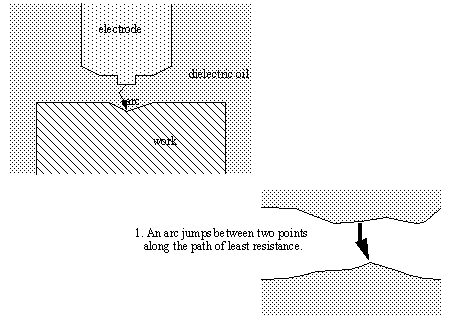1. ELECTRIC DISCHARGE MACHINING (EDM)2. bring the electrode near a metal workpiece (oppositely charged). 3. as the two conductors get close enough a spark will arc across a dielectric fluid. This spark will “burn” a small hole in the electrode and workpiece. 4. continue steps 1-3 until a hole the shape of the electrode is formed. • The process is based on melting temperature, not hardness, so some very hard materials can be machined this way. • The arc that jumps heats the metal, and about 1 to 10% of the molten metal goes into the fluid. The melted then recast layer is about 1 to 30 micro m thick, and is generally hard and rough. • typical electrode materials are, • The user can select the following parameters - working current density Id (A/cm2) - metal removal rate Vw (mm3/min) - relative electrode wear theta (% or a fraction) 
- surface finish R (peak to valley micro m) - gap between electrode and workpiece - fluid is used to act as a dielectric, and to help carry away debris. - if the fluid is pumped through and out the end of the electrode, particles will push out, and mainly collect at the edges. They will lower the dielectric resistance, resulting in more arcs. As a result the holes will be conical. - if fluid is vacuum pumped into the electrode tip, straight holes will result. - quite often kerosene-based oil. • The electrode workpiece gap is in the range of <10 micro m to <100 micro m. • Uses a voltage discharge of 60 to 300 V to give a transient arc lasting from 0.1 micro s to 8 ms. • Typical cycle time is 20 ms or less, up to millions of cycles may be required for completion of the part. • Electrode materials are high temperature, but easy to machine, thus allowing easy manufacture of complex shapes. • When the energy density is higher (machining faster), the results are, - energy density (lower to higher) - amount machined (less to more) - machining speed (slower to faster) - surface roughness (fine to rough) • Keep in mind the power is given by P=V I t 



• Rotating the wire in an orbital direction will, - increase accuracy in form and surface finish • Typical machine parameters are, 
1.1 WIRE EDM1.2 PRACTICE PROBLEMS1.3 REFERENCES |